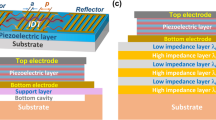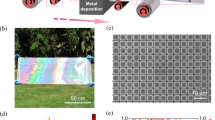Abstract
3D printing is evolving into a standard tool for prototyping various optical components suitable for application in the terahertz range of the electromagnetic spectrum. This work takes the next step in this evolution by demonstrating the fabrication and subsequent evaluation of Fabry–Pérot interferometers (FPIs). Large optical area (centimetre scale) Fabry–Pérot transmission filters have been 3D printed with polylactic acid (PLA) using a commonly used low-cost 3D printer. The advantages of the proposed approach include low cost, rapid prototyping and repeatability. Terahertz transmission measurements for two demonstrated filter designs realised to target optimisation of either signal transmission or spectral filter performance have been performed using terahertz time-domain spectroscopy (THz-TDS) and demonstrate good agreement with the simulated response in the operating spectral band of 0.30–0.75 THz (wavelengths from 1000 down to 400 μm). The critical spectral characteristics assessed were the filter peak transmission magnitude, central wavelength and full width at half-maximum (FWHM) of the transmission peak, as well as the free spectral range (FSR). The signal transmission levels were observed to reach beyond 90% for the first series of filters that targeted optimisation of this aspect; however, this was accompanied by diminished out-of-band rejection and broader transmission peaks in comparison to the second series of filters which targeted the overall performance. For the latter filter series, the resolution in terms of FWHM values of the transmission peaks was reduced to 40–50 GHz, with the out-of-band rejection approaching a ratio of 10:1. This level of spectral performance, along with the achieved signal peak transmission characteristics of 65–75%, provides adequate performance for many applications harnessing the terahertz spectral range.






Similar content being viewed by others
Data Availability
The data that support the findings of this study are available from the authors on reasonable request.
References
S. S. Dhillon et al., “The 2017 terahertz science and technology roadmap,” J. Phys. Appl. Phys., vol. 50, no. 4, p. 043001, Feb. 2017, https://doi.org/10.1088/1361-6463/50/4/043001.
J.-L. Coutaz, F. Garet, and V. P. Wallace, Principles of terahertz time-domain spectroscopy. New York: Jenny Stanford Publishing, 2018. https://doi.org/10.1201/b22478.
E. Castro-Camus, M. Koch, and D. M. Mittleman, “Recent advances in terahertz imaging: 1999 to 2021,” Appl. Phys. B, vol. 128, no. 1, p. 12, Jan. 2022, https://doi.org/10.1007/s00340-021-07732-4.
Tao, A. Fitzgerald, and V. Wallace, “Non-contact, non-destructive testing in various industrial sectors with terahertz technology,” Sensors, vol. 20, p. 712, Jan. 2020, https://doi.org/10.3390/s20030712.
C. Jördens and M. Koch, “Detection of foreign bodies in chocolate with pulsed terahertz spectroscopy,” Opt. Eng., vol. 47, no. 3, p. 037003, Mar. 2008, https://doi.org/10.1117/1.2896597.
D. Zimdars et al., “Technology and applications of terahertz imaging non-destructive examination: inspection of space shuttle sprayed on foam insulation,” AIP Conf. Proc., vol. 760, no. 1, pp. 570–577, Apr. 2005, https://doi.org/10.1063/1.1916726.
J. A. Zeitler et al., “Drug hydrate systems and dehydration processes studied by terahertz pulsed spectroscopy,” Int. J. Pharm., vol. 334, no. 1–2, pp. 78–84, Apr. 2007, https://doi.org/10.1016/j.ijpharm.2006.10.027.
S. F. Busch, M. Weidenbach, M. Fey, F. Schäfer, T. Probst and M. Koch, “Optical properties of 3D printable plastics in the THz regime and their application for 3D printed THz optics,” J Infrared Milli Terahz Waves, 35, 993–997, https://doi.org/10.1007/s10762-014-0113-9
D. Grischkowsky, S. Keiding, M. van Exter, and C. Fattinger, “Far-infrared time-domain spectroscopy with terahertz beams of dielectrics and semiconductors,” JOSA B, vol. 7, no. 10, pp. 2006–2015, Oct. 1990, https://doi.org/10.1364/JOSAB.7.002006.
C. Jördens et al., “Dielectric fibres for low-loss transmission of millimetre waves and its application in couplers and splitters,” J. Infrared Millim. Terahertz Waves, vol. 31, no. 2, p. 214, Sep. 2009, https://doi.org/10.1007/s10762-009-9568-5.
C. Jansen, S. Wietzke, V. Astley, D. M. Mittleman, and M. Koch, “Mechanically flexible polymeric compound one-dimensional photonic crystals for terahertz frequencies,” Appl. Phys. Lett., vol. 96, p. 111108, Mar. 2010, https://doi.org/10.1063/1.3341309.
M. Wichmann et al., “Terahertz Brewster lenses,” Opt. Express, vol. 19, no. 25, pp. 25151–25160, Dec. 2011, https://doi.org/10.1364/OE.19.025151.
C. Goy, M. Scheller, B. Scherger, V. P. Wallace, and M. Koch, “Terahertz waveguide prism,” Opt. Express, vol. 21, no. 16, pp. 19292–19301, Aug. 2013, https://doi.org/10.1364/OE.21.019292.
M. Liu et al., “Ultrathin tunable terahertz absorber based on MEMS-driven metamaterial,” Microsyst. Nanoeng., vol. 3, no. 1, p. 17033, Dec. 2017, https://doi.org/10.1038/micronano.2017.33.
A. D. Squires, E. Constable, and R. A. Lewis, “3D printed terahertz diffraction gratings and lenses," J. Infrared Millim. Terahertz Waves, vol. 36, no. 1, pp. 72–80, Jan. 2015, https://doi.org/10.1007/s10762-014-0122-8.
G Hernandez, Fabry-perot interferometers (no.3). Cambridge University Press, 1988.
P. Balzerowski, E. Bründermann, and M. Havenith, “Fabry–Pérot cavities for the terahertz spectral range based on high-reflectivity multilayer mirrors,” IEEE Trans. Terahertz Sci. Technol., vol. 6, no. 4, pp. 563–567, Jul. 2016, https://doi.org/10.1109/TTHZ.2016.2572361.
D. Turchinovich, A. Kammoun, P. Knobloch, T. Dobbertin, and M. Koch, “Flexible all-plastic mirrors for the THz range,” Appl. Phys. Mater. Sci. Process., vol. 74, pp. 291–293, Feb. 2002, https://doi.org/10.1007/s003390101036.
M. Martyniuk et al., “Optical microelectromechanical systems technologies for spectrally adaptive sensing and imaging,” Adv. Funct. Mater., vol. 32, no. 3, p. 2103153, 2022, https://doi.org/10.1002/adfm.202103153.
H. Mao et al., “Large-area MEMS tunable Fabry–Perot filters for multi/hyperspectral infrared imaging,” IEEE J. Sel. Top. Quantum Electron., vol. 23, no. 2, pp. 45–52, Mar. 2017, https://doi.org/10.1109/JSTQE.2016.2643782.
H. Mao et al., "MEMS-based tunable Fabry–Perot filters for adaptive multispectral thermal imaging,” J. Microelectromechanical Syst., vol. 25, no. 1, pp. 227–235, Feb. 2016, https://doi.org/10.1109/JMEMS.2015.2509058.
H. Mao et al., “Ge/ZnS-based micromachined Fabry–Perot filters for optical MEMS in the longwave infrared,” J. Microelectromechanical Syst., vol. 24, no. 6, pp. 2109–2116, Dec. 2015, https://doi.org/10.1109/JMEMS.2015.2474858.
M. Ebermann, N. Neumann, K. Hiller, M. Seifert, M. Meinig, and S. Kurth, “Tunable MEMS Fabry-Pérot filters for infrared microspectrometers: a review,” in MOEMS and Miniaturized Systems XV, Mar. 2016, vol. 9760, pp. 64–83. https://doi.org/10.1117/12.2209288.
D. K. Tripathi et al., “Suspended large-area MEMS-based optical filters for multispectral shortwave infrared imaging applications,” J. Microelectromechanical Syst., vol. 24, no. 4, pp. 1102–1110, Aug. 2015, https://doi.org/10.1109/JMEMS.2014.2385081.
F. Rutz, M. Koch, L. Micele, and G. de Portu, “Ceramic dielectric mirrors for the terahertz range,” Appl. Opt., vol. 45, no. 31, pp. 8070–8073, Nov. 2006, https://doi.org/10.1364/AO.45.008070.
Y. Li, Y. Xiang, S. Wen, J. Yong, and D. Fan, “Tunable terahertz-mirror and multi-channel terahertz-filter based on one-dimensional photonic crystals containing semiconductors,” J. Appl. Phys., vol. 110, no. 7, p. 073111, Oct. 2011, https://doi.org/10.1063/1.3650245.
W. Withayachumnankul, B. M. Fischer, and D. Abbott, “Quarter-wavelength multilayer interference filter for terahertz waves,” Opt. Commun., vol. 281, no. 9, pp. 2374–2379, 2008.
R. Schiwon, G. Schwaab, E. Bründermann, and M. Havenith, “Far-infrared multilayer mirrors,” Appl. Phys. Lett., vol. 83, no. 20, pp. 4119–4121, Nov. 2003, https://doi.org/10.1063/1.1627479.
Andrew Donald Squires, “Terahertz technology and applications_3D printing and art conservation.”
H. A. Macleod, Thin-film optical filters. CRC press, 2010.
M. Born and E. Wolf, Principles of optics: electromagnetic theory of propagation, interference, and diffraction of light. Elsevier, 2013.
G R Fowles, Introduction to modern optics. Courier Corporation, 1989.
M. Naftaly et al., “Non-destructive porosity measurements of 3D printed polymer by terahertz time-domain spectroscopy,” Appl. Sci., vol. 12, no. 2, Art. no. 2, 2022, https://doi.org/10.3390/app12020927.
E. Castro-Camus, M. Koch, and A.I. Hernandez-Serrano, “Additive manufacture of photonic components for the terahertz band,” Journal of Applied Physics, vol. 127, no. 21, p. 210901, June 2020, https://doi.org/10.1063/1.5140270.
Acknowledgements
This work was performed in the Western Australian node of the Australian National Fabrication Facility (ANFF), a company established under the National Collaborative Research Infrastructure Strategy to provide nano and micro-fabrication facilities for Australian researchers. The authors would like to thank the Australian Research Council and the Western Australian Government’s Department of Jobs, Tourism, Science and Innovation for supporting this work.
Funding
This work was supported in part by the Australian Research Council, the Australian National Fabrication Facility and the Western Australian Government’s Department of Jobs, Tourism, Science and Innovation.
Author information
Authors and Affiliations
Contributions
M. M. and K. W. conceptualised the devices. P. R and K.W. fabricated the devices. P.R. and V.W. characterised the devices. All authors analysed the characterisation data and device performance. P. R., D. S. and M. M. wrote the manuscript and prepared the figures. K. W., V. W., L F. and M. M. reviewed the manuscript.
Corresponding author
Ethics declarations
Ethical Approval
Not applicable.
Competing Interests
The authors declare no competing interests.
Additional information
Publisher's Note
Springer Nature remains neutral with regard to jurisdictional claims in published maps and institutional affiliations.
Rights and permissions
About this article
Cite this article
Revuri, P.K., Walus, K., Wallace, V.P. et al. 3D Printed Fabry–Pérot Filters for Terahertz Spectral Range. J Infrared Milli Terahz Waves 43, 942–956 (2022). https://doi.org/10.1007/s10762-022-00887-x
Received:
Accepted:
Published:
Issue Date:
DOI: https://doi.org/10.1007/s10762-022-00887-x




